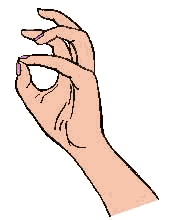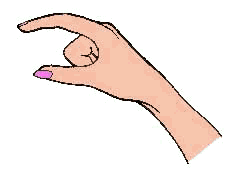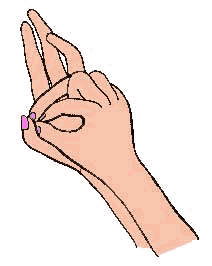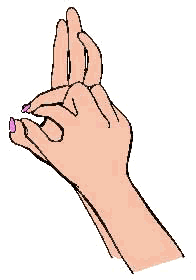KINESIOLOGY
Self
- Testing
Courtesy
of Perelandra - Center for Nature Research
The Overall Concept Behind
Kinesiology
What enhances our body, mind and soul makes
us strong. Together, our body, mind and soul create an environment that, when
balanced, is strong and solid. If something enters that environment and
challenges the balance, the environment is weakened. That strength or weakness
first registers in the bodies electrical system, and it can be discerned through
the muscle-testing technique—kinesiology. If the finger testing shows
positive or strong, then the item we are testing for (vitamins) is
appropriate for our current use. If the finger testing shows negative or weak,
then it is not appropriate for our current use. Testing determines
present time and appropriateness. This may change with time, depending
Ways to Make Use of
Kinesiology
-
Test if a certain remedy, vitamin or food is
appropriate for your body.
-
Test for life energy in fresh fruit or
vegetables
-
Test if foods you are purchasing have been
irradiated.
-
Test if specific healer or modality is
appropriate for your health support.
Kinesiology
Self-Testing Steps
1. THE CIRCUIT FINGERS. If
you are right-handed: Place your left hand palm up. Connect the tip of your left
thumb with the tip of the left little finger (not your index finger). If you are
 left-handed:
Place your right hand palm up. Connect the tip of your right thumb with the tip
of your right little finger. By connecting your thumb and little finger, you
have closed an electrical circuit in your hand, and it is this circuit you will
use for testing.
left-handed:
Place your right hand palm up. Connect the tip of your right thumb with the tip
of your right little finger. By connecting your thumb and little finger, you
have closed an electrical circuit in your hand, and it is this circuit you will
use for testing.
Before going on, look at the position you have just formed
with your hand. If your thumb is touching the tip of your index or first finger,
laugh at yourself for not being able to follow directions, and change the
position to touch the tip of the thumb with the tip of the little or fourth
finger. Most likely this will not feel at all comfortable to you. If you are
feeling a weird sense of awkwardness, you’ve got the first step of the test
position! In time, the hand and fingers will adjust to being put in this
position and it will feel fine. Circuit fingers can touch tip to tip, finger pad to finger
pad, or thumb resting on top of the little finger’s nail. Women with long
nails need not impale themselves.
2. THE TEST FINGERS. To test
the circuit (the means by which you will apply pressure to
 yourself),
place the thumb and index finger of your other hand inside the circle you have
created by connecting your thumb and little finger. The thumb and index finger
should be right under your thumb and your little finger, touching them. Don’t
try to make a circle with your test fingers. They are just placed inside the
circuit fingers that do form a circle. It will look as if the circuit fingers
are resting on the test fingers.
yourself),
place the thumb and index finger of your other hand inside the circle you have
created by connecting your thumb and little finger. The thumb and index finger
should be right under your thumb and your little finger, touching them. Don’t
try to make a circle with your test fingers. They are just placed inside the
circuit fingers that do form a circle. It will look as if the circuit fingers
are resting on the test fingers.
3. POSITIVE RESPONSE. Keeping
this position, ask yourself a yes/no question in which you already know the
answer to be yes. ("Is my name _____?") Once you’ve asked the
 question,
press your circuit fingers together, keeping the tip-to-tip position. Using
the same amount of pressure, try to pull apart the circuit fingers with your
test fingers. Press the lower thumb against the upper thumb, and the lower index
finger against the upper little finger.
question,
press your circuit fingers together, keeping the tip-to-tip position. Using
the same amount of pressure, try to pull apart the circuit fingers with your
test fingers. Press the lower thumb against the upper thumb, and the lower index
finger against the upper little finger.
The action of your test fingers will look like scissors
separating as you apply pressure to your circuit fingers. The motion of the test
fingers is horizontal. Don’t try to pull your test fingers vertically up
through your circuit fingers. This action sometimes works but it is not as
reliable as the horizontal scissors action.
The circuit position described in step 1 corresponds to
the position you take when you stick your arm out for the physician. The testing
position in step 2 is in place of the physician or other convenient arm pumper.
After you ask the yes/no question and you press your circuit fingers tip-to-tip,
that is equal to the doctor saying, "Resist my pressure." Your circuit
fingers now correspond to your outstretched, stiffened arm. Trying to pull apart
those fingers with your testing fingers is equal to the doctor pressing down on
your arm.
If the answer to the question is positive (if your name is
what you think it is!), you will not be able to easily push apart the circuit
fingers. The electrical circuit will hold, your muscles will maintain their
strength, and your circuit fingers will not separate. You will feel the strength
in that circuit.
IMPORTANT: Be sure the amount of
pressure holding the circuit fingers together is equal to the amount of your
testing fingers pressing against them. Also, don’t use a pumping action in
your test fingers when applying pressure to your circuit fingers. Use an equal,
steady and continuous pressure.
Play with this a bit. Ask a few more yes/no questions that
have positive answers. Now, I know it is going to seem that if you already know
the answer to be "yes," you are probably "throwing" the
test. That’s reasonable, but for the time being, until you get a feeling for
what the positive response feels like, you’re going to need to deliberately
ask yourself questions with positive answers.
While asking questions, if you are having trouble sensing
the strength of the circuit, apply a little more pressure. Or consider that you
may be applying too much pressure and pull back some. You don’t have to break
or strain your fingers for this; just use enough pressure to make them feel
alive, connected and alert.
4. NEGATIVE RESPONSE. Once
you have a clear sense of the positive response, ask yourself a question that
has a negative answer. Again press your circuit fingers together and, using
 equal
pressure, press against the circuit fingers with the test fingers. This time the
electrical circuit will break and the circuit fingers will weaken and separate.
Because the electrical circuit is broken, the muscles in the circuit fingers do
not have the power to easily hold the fingers together. In a positive state the
electrical circuit holds, and the muscles have the power to keep the two fingers
together.
equal
pressure, press against the circuit fingers with the test fingers. This time the
electrical circuit will break and the circuit fingers will weaken and separate.
Because the electrical circuit is broken, the muscles in the circuit fingers do
not have the power to easily hold the fingers together. In a positive state the
electrical circuit holds, and the muscles have the power to keep the two fingers
together.
How much your circuit fingers separate depends on your
personal style. Some people’s fingers separate a lot. Other’s barely
separate at all. Mine separate about a quarter of an inch. Some people’s
fingers won’t separate at all, but they’ll definitely feel the fingers
weaken when pressure is applied during a "no" answer. Give yourself
time and let your personal style develop naturally.
Also, if you are having a little trouble feeling anything,
do your testing with your forearms resting in your lap. This way you won’t be
using your muscles to hold up your arms while trying to test.
Play with negative questions a bit, and then return to
positive questions. Get a good feeling for the strength between your circuit
fingers when your electrical system is balanced and the weakness when it is
short-circuited or imbalanced. You can even ask yourself (your own system) for a
positive response and then, after testing, ask for a negative response.
("Give me a positive response." Test. "Give me a negative
response." Test.) You will feel the positive strength and the negative
weakness. In the beginning, you may feel only a slight difference between the
two. With practice, that difference will become more pronounced. For now, it is
just a matter of trusting what you have learned—and practicing.
Back
 left-handed:
Place your right hand palm up. Connect the tip of your right thumb with the tip
of your right little finger. By connecting your thumb and little finger, you
have closed an electrical circuit in your hand, and it is this circuit you will
use for testing.
left-handed:
Place your right hand palm up. Connect the tip of your right thumb with the tip
of your right little finger. By connecting your thumb and little finger, you
have closed an electrical circuit in your hand, and it is this circuit you will
use for testing. yourself),
place the thumb and index finger of your other hand inside the circle you have
created by connecting your thumb and little finger. The thumb and index finger
should be right under your thumb and your little finger, touching them. Don’t
try to make a circle with your test fingers. They are just placed inside the
circuit fingers that do form a circle. It will look as if the circuit fingers
are resting on the test fingers.
yourself),
place the thumb and index finger of your other hand inside the circle you have
created by connecting your thumb and little finger. The thumb and index finger
should be right under your thumb and your little finger, touching them. Don’t
try to make a circle with your test fingers. They are just placed inside the
circuit fingers that do form a circle. It will look as if the circuit fingers
are resting on the test fingers. question,
press your circuit fingers together, keeping the tip-to-tip position. Using
the same amount of pressure, try to pull apart the circuit fingers with your
test fingers. Press the lower thumb against the upper thumb, and the lower index
finger against the upper little finger.
question,
press your circuit fingers together, keeping the tip-to-tip position. Using
the same amount of pressure, try to pull apart the circuit fingers with your
test fingers. Press the lower thumb against the upper thumb, and the lower index
finger against the upper little finger. equal
pressure, press against the circuit fingers with the test fingers. This time the
electrical circuit will break and the circuit fingers will weaken and separate.
Because the electrical circuit is broken, the muscles in the circuit fingers do
not have the power to easily hold the fingers together. In a positive state the
electrical circuit holds, and the muscles have the power to keep the two fingers
together.
equal
pressure, press against the circuit fingers with the test fingers. This time the
electrical circuit will break and the circuit fingers will weaken and separate.
Because the electrical circuit is broken, the muscles in the circuit fingers do
not have the power to easily hold the fingers together. In a positive state the
electrical circuit holds, and the muscles have the power to keep the two fingers
together.